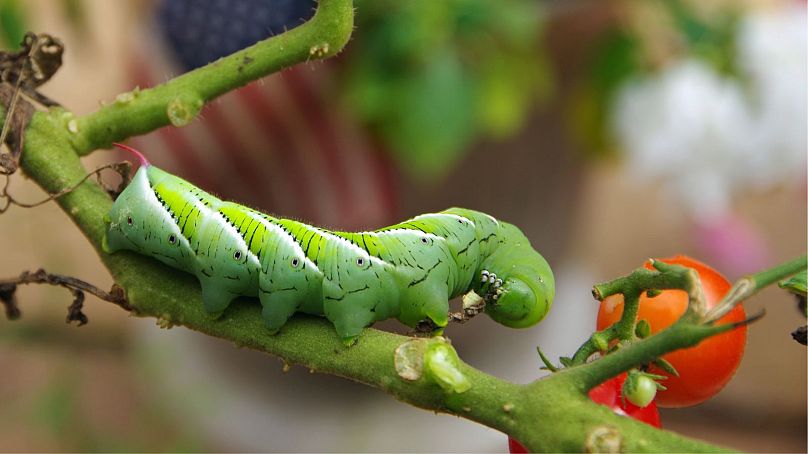Heirloom vs hybrid tomatoes: Scientists find organic plants can fight off caterpillars better.
Plants can do astonishing things. As if the wonders of photosynthesis aren’t enough - producing oxygen from the sun to enable virtually all life on Earth - people have collaborated with plants on some mind-blowing projects.
Scientists have taught spinach to send emails; generated electricity from shrubs; and discovered how they teach their offspring to adapt to climate change.
But some of the things humans are doing to plants are also limiting their powers, a new study on tomatoes shows.
Researchers at the University of Illinois Urbana-Champaign have investigated what happens when tomatoes are visited by ‘friends’ and ‘foes’ - beneficial soil microbes and caterpillars. Their results take us deeper into the communication style of one of the world’s tastiest species.
Esther Ngumbi, an assistant professor of integrative biology at the university and co-author of the recent study, is evangelical about “the gospel of plant chemistry.”
“People tend to think that plants are not intelligent, but our studies have shown that they are actively responding to the environment around them using chemistry,” she says.
How do plants communicate?
Plant chemistry, Ngumbi adds, is the language that plants use to communicate. It takes the form of volatile organic compounds (VOCs) which they produce to influence the outside world.
VOCs can be sent out by plants for various reasons - such as signalling an injury; preparing their defences, or warning each other of threats in the environment. Sometimes humans can pick up on these signals too - catching the scent of cut grass, for example.
These chemical messages can also be used to recruit beneficial soil microbes that help plants grow, such as arbuscular mycorrhizal fungi (AMF). Or to tell insect predators that there is a pest chewing on its leaves that it wants gone.
"When a caterpillar chews on a leaf, the plant sends out a signal that calls out to the caterpillar's predators. It's like a billboard that tells them where lunch is," Erinn Dady, another co-author of the study explained to the team at the Carl R. Woese Institute for Genomic Biology (IGB).
Since they can’t run away from danger, this kind of chemical fight gives plants the best chance of survival. And understanding the factors that affect VOC emissions helps us to help them.
Heirlooms vs hybrids: What are tomatoes telling us?
Building on research that looks at how soil microbes or caterpillars can influence VOCs, the researchers wanted to examine the collective impact of both friends and foes.
To broaden the field of study, they looked beyond industrially grown tomatoes to test four different varieties commonly grown by smaller-scale Illinois farmers. Two hybrids were chosen on that basis - Mountain Fresh and Valley Girl - and two organic heirlooms, Amish Paste and Cherokee Purple.
For these four varieties, the researchers compared the responses of plants left alone, to those exposed to AMF, caterpillars or both. The eight-week-old plants were encased in an odour-blocking oven bag for an hour to trap the VOCs they released. This air was then analysed for its different chemical components.
The results were…somewhat confusing. Added separately, the AMF and caterpillars decreased the volatile emissions from all four varieties of plants. And the emissions didn’t change much when both were present. It’s not totally clear why the beneficial fungi decreased the VOCs, and why the plants weren’t more responsive to the munching caterpillars.
But one key finding is that the hybrid tomatoes emitted lower quantities of VOCs compared to their heirloom neighbours.
"Heirloom tomatoes - the big, juicy tomatoes we all love - are bred for flavour. Meanwhile, hybrids are grown for large-scale conventional production, which comes at a cost to the plant," says Ngumbi.
"Our work suggests that we are compromising plant defences through our breeding processes."
Why did caterpillar-chewed plants grow more?
The tomato tests yielded one more baffling result which has led the researchers down a new line of enquiry.
They also measured the plants’ growth above ground and in the soil. Unsurprisingly, the plants with fungi associations developed more leaves and more complex root structures. Further proof of how incredible and cooperative fungi can be.
"AMF form partnerships in over 80 per cent of the land plants, setting up a trade where the fungi extract nutrients from the soil in exchange for carbon from plants," Dady explains. "We found that, especially in Cherokee Purple, AMF may confer additional benefits, including enhanced growth and greater emission of VOCs."
But the plants treated with caterpillars also had greater growth.
"These plants had more biomass in both their roots and above the ground, which seems counterintuitive because they've actively been eaten. I would assume they would have less biomass," Dady told the university site.
"It is possible that the caterpillars triggered a growth response, similar to how you prune a tree to make it produce new growth." Ngumbi also speculated that the plants could have been unbothered by the number of caterpillars, and so kept growing. Or that the caterpillars weren’t hungry enough to do real damage.
"There's a lot going on behind the scenes that we don't yet understand,” Dady added, and plenty more dialogue cues for researchers to pick up on.












